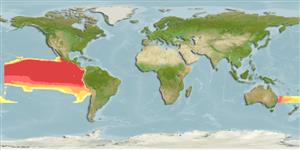Klassifizierung / Names
Namen | Synonyme | Catalog of Fishes(Gattung, Arten) | ITIS | CoL | WoRMS | Cloffa
>
Argentiniformes (Marine smelts) >
Bathylagidae (Deep-sea smelts)
Etymology: Bathylagoides: Greek, bathys = deep + Greek, lagoides = similar to a hare (Ref. 45335).
Environment: milieu / climate zone / depth range / distribution range
Ökologie
seewasser bathypelagisch; tiefenbereich 100 - 1500 m (Ref. 33698), usually 200 - 300 m (Ref. 33679). Deep-water; 22°N - 33°S
Pacific and Indian. Eastern Pacific: California Current region (Ref. 35604).
Size / Gewicht / Alter
Maturity: Lm ? range ? - ? cm
Max length : 10.5 cm SL Männchen/unbestimmt; (Ref. 96339)
Rückenflossenstacheln (insgesamt): 0; Rückenflossenweichstrahlen (insgesamt): 10-14; Afterflossenstacheln 0; Afterflossenweichstrahlen: 14 - 18; Wirbelzahl: 41 - 46. Deep body, relatively slender toward the end of caudal peduncle; maximum body depth slightly anterior to origin of dorsal fin in specimens 6 - 10.45 cm SL and at the level of the pectoral fin base in smaller specimens. Pectoral fins short, far from reaching origin of dorsal fin. Radial grooves present in the hind part of operculum. Few gill rakers at the inner surface of epibranchial of the first gill arch (Ref. 33679). Branchiostegal rays: 2.
Undergoes daily vertical migrations, rising into the epipelagic zone during the night. Feeds mainly on zooplankton (Ref. 9875, 33698). Oviparous, with planktonic eggs and larvae (Ref. 35604).
Life cycle and mating behavior
Geschlechtsreife | Fortpflanzung | Ablaichen | Eier | Fecundity | Larven
Gorelova, T.A. and S.G. Kobylyanskiy, 1985. Feeding of deepsea fishes of the Family Bathylagidae. J. Ichthyol. 25(3):89-100. (Ref. 33698)
IUCN Rote Liste Status (Ref. 130435)
Bedrohung für Menschen
Harmless
Nutzung durch Menschen
Fischereien: nicht kommerziell
Mehr Information
ReferenzenAquakulturAquakultur ProfilZuchtlinienGenetikElectrophoresesVererbbarkeitKrankheitenVerarbeitungNutrientsMass conversion
PartnerBilderStamps, Coins Misc.LauteCiguateraGeschwindigkeitSchwimmstilKiemenoberflächeOtolithsGehirngrößeSehfähigkeit
Tools
Zusatzinformationen
Download XML
Internet Quellen
Estimates based on models
Preferred temperature (Ref.
123201): 3.3 - 12.6, mean 5 °C (based on 16 cells).
Phylogenetic diversity index (Ref.
82804): PD
50 = 0.6250 [Uniqueness, from 0.5 = low to 2.0 = high].
Bayesian length-weight: a=0.00513 (0.00205 - 0.01282), b=3.00 (2.79 - 3.21), in cm total length, based on LWR estimates for this (Sub)family-body shape (Ref.
93245).
Trophic level (Ref.
69278): 3.4 ±0.42 se; based on food items.
Widerstandsfähigkeit (Ref.
120179): mittel, Verdopplung der Population dauert 1,4 - 4,4 Jahre. (Preliminary K or Fecundity.).
Fishing Vulnerability (Ref.
59153): Low vulnerability (10 of 100).
